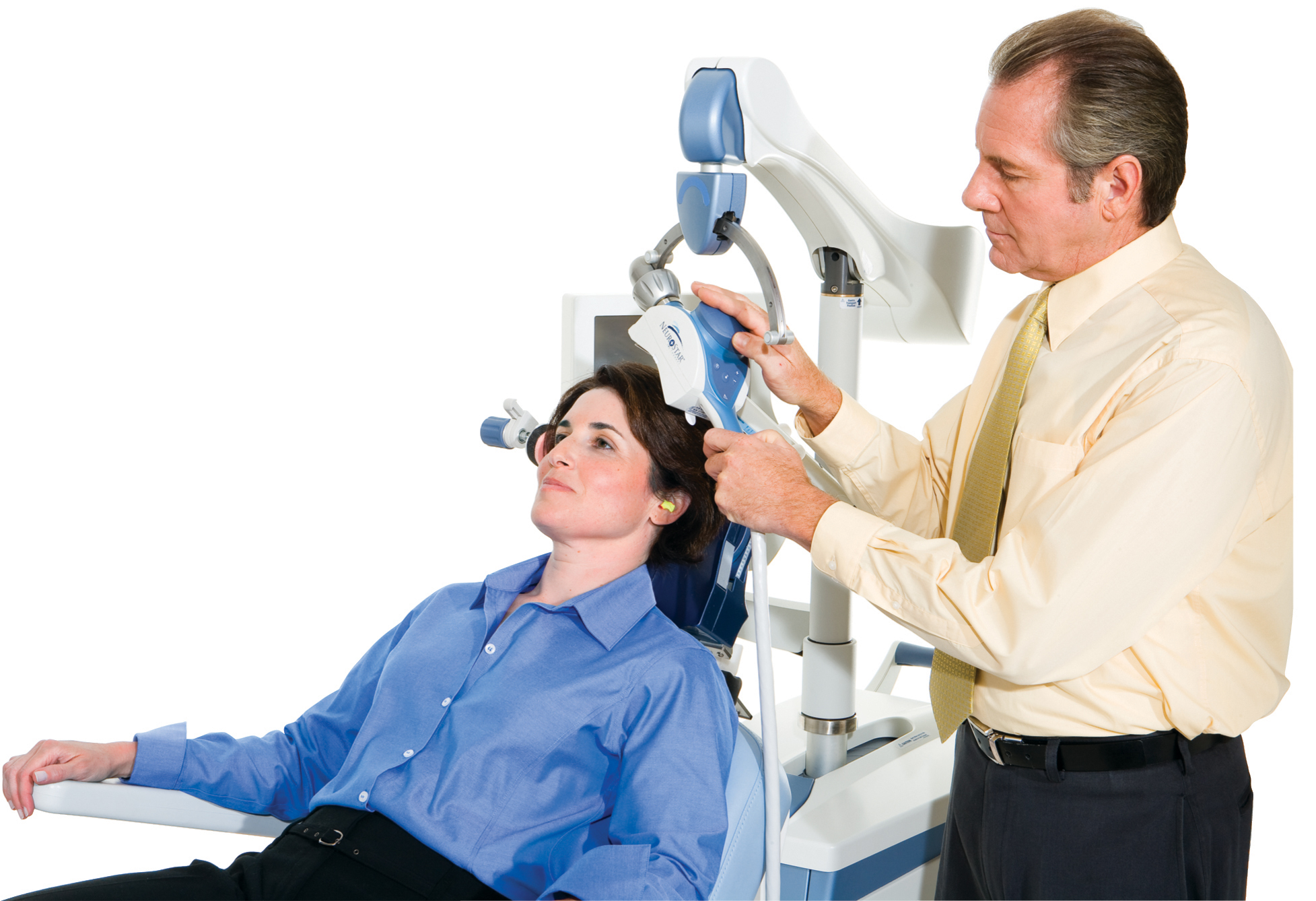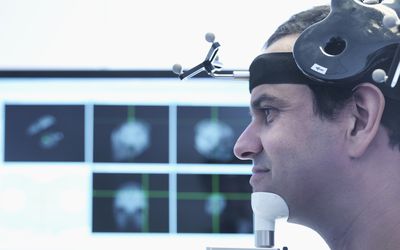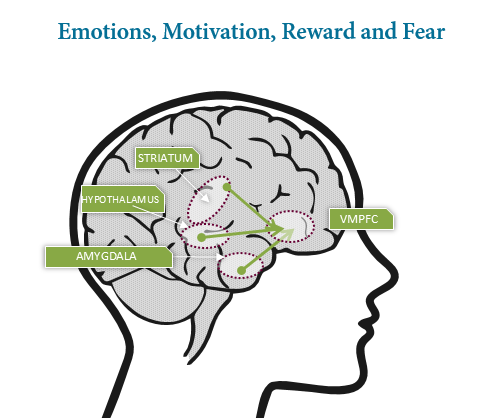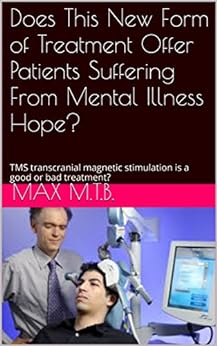Transcranial magnetic stimulation patient reviews Bowsers Corner

Does TMS Hold Promise for Generalized Anxiety Disorder Transcranial Magnetic Stimulation (TMS) has proven safe and effective with over 1 million treatments provided in the United States. Patients who have completed TMS Therapy for Depression are sharing personal TMS reviews of the treatment process and treatment outcomes.
Is There Evidence for Effectiveness of Transcranial
Am I a Candidate for TMS Therapy?. May 24, 2018 · One such treatment is transcranial magnetic stimulation A patient receiving NeuroStar TMS therapy. NeuroStar. TMS has been used for more than a …, Transcranial Magnetic Stimulation (TMS) has proven safe and effective with over 1 million treatments provided in the United States. Patients who have completed TMS Therapy for Depression are sharing personal TMS reviews of the treatment process and treatment outcomes..
May 21, 2019В В· TMS or Transcranial Magnetic Stimulation is a safe and non-invasive therapy that is approved to treat treatment-resistant depression. TMS therapy uses repetitive pulses of an MRI-strength magnetic field placed over the scalp. TMS is also sometimes called repetitive transcranial magnetic stimulation, or rTMS. Transcranial magnetic stimulation (TMS), since its introduction in 1985, has been studied for its efficacy in different psychiatric disorders. It has been touted to be an effective treatment modality for major depression, obsessive compulsive disorder, Tourette syndrome, and in reducing auditory hallucinations in patients with schizophrenia.
Transcranial Magnetic Stimulation What is Transcranial Magnetic Stimulation (TMS)? TMS is a mild form of brain stimulation. Magnetic fields, generated by a simple coil placed on the head, are used to stimulate a small area of the brain. The stimulation takes 20-30 minutes and is typically given over consecutive weekdays on an outpatient basis. About TMS & Brain Health. TMS & Brain Health is an innovative brain health center based in Santa Monica, California. We are proud to be the first clinic in Southern California to specialize in Express Transcranial Magnetic Stimulation (TMS), Ketamine infusion therapy, Spravatoв„ў Esketamine nasal spray, and neurofeedback.
Transcranial Magnetic Stimulation (TMS) is a non-invasive method of brain stimulation used to treat major depression in the Johns Hopkins Brain Stimulation Program. Skip Navigation. Menu. The patient can stop a treatment at any time by asking the staff member present. Transcranial Magnetic Stimulation (TMS) Therapy. Transcranial Magnetic Stimulation (TMS) is a novel form of Brain Stimulation used to treat patients whose condition has not improved through conventional approaches.. Benefits of TMS. Unlike other treatments, such as medications, TMS is not associated with the common side effects of weight gain, sexual problems, sleepiness or memory loss.
Apr 17, 2017 · The reason that the NeuroStar regimen is effective is due to the unique approach that they have on the body. The entire regimen centers around transcranial magnetic stimulation. Transcranial magnetic stimulation (TMS) uses magnetic fields to target certain areas, which is fairly similar to the way that an MRI machine works. May 24, 2018 · One such treatment is transcranial magnetic stimulation A patient receiving NeuroStar TMS therapy. NeuroStar. TMS has been used for more than a …
Brain stimulation therapies involve activating or touching the brain directly with electricity, magnets, or implants to treat depression and other disorders. Electroconvulsive therapy is the most researched stimulation therapy and has the longest history of use. Other stimulation therapies discussed here vagus nerve stimulation, repetitive transcranial magnetic stimulation, magnetic seizure Transcranial Magnetic Stimulation What is Transcranial Magnetic Stimulation (TMS)? TMS is a mild form of brain stimulation. Magnetic fields, generated by a simple coil placed on the head, are used to stimulate a small area of the brain. The stimulation takes 20-30 minutes and is typically given over consecutive weekdays on an outpatient basis.
May 21, 2019В В· TMS or Transcranial Magnetic Stimulation is a safe and non-invasive therapy that is approved to treat treatment-resistant depression. TMS therapy uses repetitive pulses of an MRI-strength magnetic field placed over the scalp. TMS is also sometimes called repetitive transcranial magnetic stimulation, or rTMS. About TMS & Brain Health. TMS & Brain Health is an innovative brain health center based in Santa Monica, California. We are proud to be the first clinic in Southern California to specialize in Express Transcranial Magnetic Stimulation (TMS), Ketamine infusion therapy, Spravatoв„ў Esketamine nasal spray, and neurofeedback.
Transcranial Magnetic Stimulation What is Transcranial Magnetic Stimulation (TMS)? TMS is a mild form of brain stimulation. Magnetic fields, generated by a simple coil placed on the head, are used to stimulate a small area of the brain. The stimulation takes 20-30 minutes and is typically given over consecutive weekdays on an outpatient basis. In general, almost none of the studies using TMS for anxiety have involved the use of “sham TMS” and thus placebo response cannot be ruled out. Finally, a note about TMS. Transcranial magnetic stimulation (TMS) of the brain takes many forms and the response to TMS depends on several factors.
Transcranial Magnetic Stimulation (TMS) is a non-invasive method of brain stimulation used to treat major depression in the Johns Hopkins Brain Stimulation Program. Skip Navigation. Menu. The patient can stop a treatment at any time by asking the staff member present. Nov 17, 2017 · Can Transcranial Magnetic Stimulation Help With Depression? Medical School and director of the transcranial magnetic stimulation clinical service at …
Transcranial Magnetic Stimulation (TMS) is a non-invasive method of brain stimulation used to treat major depression in the Johns Hopkins Brain Stimulation Program. Skip Navigation. Menu. The patient can stop a treatment at any time by asking the staff member present. In general, almost none of the studies using TMS for anxiety have involved the use of “sham TMS” and thus placebo response cannot be ruled out. Finally, a note about TMS. Transcranial magnetic stimulation (TMS) of the brain takes many forms and the response to TMS depends on several factors.
Transcranial magnetic stimulation (TMS), since its introduction in 1985, has been studied for its efficacy in different psychiatric disorders. It has been touted to be an effective treatment modality for major depression, obsessive compulsive disorder, Tourette syndrome, and in reducing auditory hallucinations in patients with schizophrenia. Transcranial Magnetic Stimulation (TMS) Therapy. Transcranial Magnetic Stimulation (TMS) is a novel form of Brain Stimulation used to treat patients whose condition has not improved through conventional approaches.. Benefits of TMS. Unlike other treatments, such as medications, TMS is not associated with the common side effects of weight gain, sexual problems, sleepiness or memory loss.
Transcranial magnetic stimulation (TMS) for depression

Achieve Remission from Depression NeuroStar TMS Therapy. The most common side effect is pain or discomfort at or near the treatment site. These events are transient; they occur during the TMS treatment course and do not occur for most patients after the first week of treatment. There is a rare risk of seizure associated with …, Jul 21, 2018 · Dr. Simon Kung, a psychiatrist at Mayo Clinic, explains how transcranial magnetic stimulation is used to treat depression. This interview originally aired July 21, 2018..
Frequently Asked Questions About TMS at The Johns Hopkins. Oct 15, 2012В В· The treatment, called transcranial magnetic stimulation (TMS), sends short pulses of magnetic fields to the brain. "I feel better now than I have in a very long time," said patient Jannel Jump., May 21, 2019В В· TMS or Transcranial Magnetic Stimulation is a safe and non-invasive therapy that is approved to treat treatment-resistant depression. TMS therapy uses repetitive pulses of an MRI-strength magnetic field placed over the scalp. TMS is also sometimes called repetitive transcranial magnetic stimulation, or rTMS..
TMS Patient Testimonials Mohawk Hudson TMS Center

Efficacy of transcranial magnetic stimulation for. – Patient A * I am 50 years old and working as a personal care attendant. I experienced my first episode of depression in 1986 and have had around seven episodes, all ranging anywhere from 1 to 6 years. My depression alienated me and made me feel isolated from the people that love and care about me the most. I lost a job because of it. https://upload.wikimedia.org/wikipedia/commons/e/e0/Brain_Stimulation_in_Alzheimer%27s_Disease.pdf Transcranial magnetic stimulation (TMS), since its introduction in 1985, has been studied for its efficacy in different psychiatric disorders. It has been touted to be an effective treatment modality for major depression, obsessive compulsive disorder, Tourette syndrome, and in reducing auditory hallucinations in patients with schizophrenia..

Oct 08, 2018 · Transcranial magnetic stimulation (TMS) is a neurophysiological procedure for noninvasive stimulation of the nervous system. It involves the application of rapidly changing magnetic field to the superficial layers of the cerebral cortex, which locally induces small electric currents, known as “Eddy or Foucault currents.” One of the abstracts presented at the May 2013 APA annual conference in San Francisco was called A Multisite, Longitudinal, Naturalistic Observational Study of Transcranial Magnetic Stimulation (TMS) For Major Depression in Clinical Practice, by Mark Demitrack, MD, et al.
Transcranial magnetic stimulation (TMS), also known as repetitive transcranial magnetic stimulation (rTMS), is a noninvasive form of brain stimulation in which a changing magnetic field is used to cause electric current at a specific area of the brain through electromagnetic induction.An electric pulse generator, or stimulator, is connected to a magnetic coil, which in turn is connected to the Oct 15, 2012В В· The treatment, called transcranial magnetic stimulation (TMS), sends short pulses of magnetic fields to the brain. "I feel better now than I have in a very long time," said patient Jannel Jump.
Apr 17, 2017В В· The reason that the NeuroStar regimen is effective is due to the unique approach that they have on the body. The entire regimen centers around transcranial magnetic stimulation. Transcranial magnetic stimulation (TMS) uses magnetic fields to target certain areas, which is fairly similar to the way that an MRI machine works. Transcranial Magnetic Stimulation (TMS) is a non-invasive method of brain stimulation used to treat major depression in the Johns Hopkins Brain Stimulation Program. Skip Navigation. Menu. The patient can stop a treatment at any time by asking the staff member present.
Brain stimulation therapies involve activating or touching the brain directly with electricity, magnets, or implants to treat depression and other disorders. Electroconvulsive therapy is the most researched stimulation therapy and has the longest history of use. Other stimulation therapies discussed here vagus nerve stimulation, repetitive transcranial magnetic stimulation, magnetic seizure Transcranial magnetic stimulation (TMS) uses a targeted pulsed magnetic field, similar to what is used in an MRI (magnetic resonance imaging) machine. While the patient is awake and alert, NeuroStar TMS Therapy stimulates areas of the brain that are underactive in depression. 5
Transcranial magnetic stimulation treatment is a safe and effective treatment that aids mood control. The magnetic pulses move without any pain into your brain cells to stimulate them and enhance communication between various parts of your brain. The exact details about how TMS works are still not clear, but the stimulation has a profound In general, almost none of the studies using TMS for anxiety have involved the use of “sham TMS” and thus placebo response cannot be ruled out. Finally, a note about TMS. Transcranial magnetic stimulation (TMS) of the brain takes many forms and the response to TMS depends on several factors.
Patient Testimonials. Real people, real success through Transcranial Magnetic Stimulation (TMS) therapy for their depression. Oct 08, 2018 · Transcranial magnetic stimulation (TMS) is a neurophysiological procedure for noninvasive stimulation of the nervous system. It involves the application of rapidly changing magnetic field to the superficial layers of the cerebral cortex, which locally induces small electric currents, known as “Eddy or Foucault currents.”
Smart TMS is delighted to share a patient’s review of rTMS – repetitive Transcranial Magnetic Stimulation treatment for depression at their London-based clinic.. Anna shares her first hand experience of the treatment and describes how it feels as well as the life-changing results. May 24, 2018 · One such treatment is transcranial magnetic stimulation A patient receiving NeuroStar TMS therapy. NeuroStar. TMS has been used for more than a …
Jan 08, 2019 · Repetitive transcranial magnetic stimulation (rTMS) is an FDA cleared therapy for use in treating major depressive disorder (MDD). All products cleared for market use are indicated for: “Treatment of major depressive disorder in adult patients who have failed to receive satisfactory improvement from prior antidepressant medication in the current episode [1,2,3,4,5]”. Transcranial Magnetic Stimulation What is Transcranial Magnetic Stimulation (TMS)? TMS is a mild form of brain stimulation. Magnetic fields, generated by a simple coil placed on the head, are used to stimulate a small area of the brain. The stimulation takes 20-30 minutes and is typically given over consecutive weekdays on an outpatient basis.
I go home and read up on TMS, review other patient testimonials, and still can’t believe it.Today I’m almost finished with my TMS treatments and will be transitioning to maintenance treatments in the next 30 days. etc.so maybe TMS (transcranial magnetic stimulation) will work. The stimulation is supposed to enable your receptors Transcranial magnetic stimulation (TMS) uses a targeted pulsed magnetic field, similar to what is used in an MRI (magnetic resonance imaging) machine. While the patient is awake and alert, NeuroStar TMS Therapy stimulates areas of the brain that are underactive in depression. 5
Transcranial Magnetic Stimulation Transcranial Magnetic Stim ulation Therapeutic Transcranial Magnetic Stimulation Systematic Reviews and Meta-Analyses for Parkinson’s Disease Yang et al. (2018) performed a meta-analysis to evaluate the optimal rTMS parameters for motor recovery of transcranial magnetic stimulation (rTMS) trials in Jul 21, 2018 · Dr. Simon Kung, a psychiatrist at Mayo Clinic, explains how transcranial magnetic stimulation is used to treat depression. This interview originally aired July 21, 2018.

Transcranial Magnetic Stimulation FAQs; Am I A Candidate for TMS? medications should be prescribed or resumed after acute TMS therapy is completed as based on the individual patient’s psychiatric and medication history. Return to top. Call Today to see if you are a Transcranial Magnetic Stimulation FAQs; Am I A Candidate for TMS? medications should be prescribed or resumed after acute TMS therapy is completed as based on the individual patient’s psychiatric and medication history. Return to top. Call Today to see if you are a
Our Patient’s Testimonials TMS Chattanooga

Manhattan TMS NYC Psychiatrist Transcranial Magnetic. TMS (Transcranial Magnetic Stimulation) Our Promise. Principium Psychiatry offers state of the art medicine in the heart of New York City. We welcome local and international clients. zivecohenpsychiatry.com. Read patient reviews of Dr. Cohen or book an appointment on ZocDoc., Transcranial Magnetic Stimulation Overview (what is Transcranial Magnetic Stimulation) The transcranial magnetic stimulation (TMS) is a non-invasive procedure used to stimulate the smaller regions of the brain. This procedure uses a magnetic field to stimulate the nerve cells in the brain for improving the symptoms of depression..
Manhattan TMS NYC Psychiatrist Transcranial Magnetic
TRANSCRANIAL MAGNETIC STIMULATION UHCprovider.com. Transcranial Magnetic Stimulation (TMS) Therapy. Transcranial Magnetic Stimulation (TMS) is a novel form of Brain Stimulation used to treat patients whose condition has not improved through conventional approaches.. Benefits of TMS. Unlike other treatments, such as medications, TMS is not associated with the common side effects of weight gain, sexual problems, sleepiness or memory loss., Transcranial Magnetic Stimulation Overview (what is Transcranial Magnetic Stimulation) The transcranial magnetic stimulation (TMS) is a non-invasive procedure used to stimulate the smaller regions of the brain. This procedure uses a magnetic field to stimulate the nerve cells in the brain for improving the symptoms of depression..
Transcranial Magnetic Stimulation Page 1 of 4 UnitedHealthcare Medicare Advantage Policy Guideline Approved 03/13/2019 If patient is currently receiving electro-convulsive therapy, TMS may be considered reasonable and necessary as a less invasive treatment option. Transcranial Magnetic Stimulation (TMS) Therapy. Transcranial Magnetic Stimulation (TMS) is a novel form of Brain Stimulation used to treat patients whose condition has not improved through conventional approaches.. Benefits of TMS. Unlike other treatments, such as medications, TMS is not associated with the common side effects of weight gain, sexual problems, sleepiness or memory loss.
Transcranial Magnetic Stimulation (TMS) has proven safe and effective with over 1 million treatments provided in the United States. Patients who have completed TMS Therapy for Depression are sharing personal TMS reviews of the treatment process and treatment outcomes. Watch these recent segments about depression therapy using Transcranial Magnetic Stimulation (TMS) on "The Dr. Oz Show" and on "The Daily Buzz". Mohawk Hudson TMS Center was also recently featured in a recent WNYT health news piece.
One of the abstracts presented at the May 2013 APA annual conference in San Francisco was called A Multisite, Longitudinal, Naturalistic Observational Study of Transcranial Magnetic Stimulation (TMS) For Major Depression in Clinical Practice, by Mark Demitrack, MD, et al. Transcranial Magnetic Stimulation FAQs; Am I A Candidate for TMS? medications should be prescribed or resumed after acute TMS therapy is completed as based on the individual patient’s psychiatric and medication history. Return to top. Call Today to see if you are a
In general, almost none of the studies using TMS for anxiety have involved the use of “sham TMS” and thus placebo response cannot be ruled out. Finally, a note about TMS. Transcranial magnetic stimulation (TMS) of the brain takes many forms and the response to TMS depends on several factors. Transcranial magnetic stimulation (TMS), also known as repetitive transcranial magnetic stimulation (rTMS), is a noninvasive form of brain stimulation in which a changing magnetic field is used to cause electric current at a specific area of the brain through electromagnetic induction.An electric pulse generator, or stimulator, is connected to a magnetic coil, which in turn is connected to the
Nov 17, 2017 · Can Transcranial Magnetic Stimulation Help With Depression? Medical School and director of the transcranial magnetic stimulation clinical service at … Jan 30, 2015 · Transcranial magnetic stimulation (TMS) is the neuromodulation therapy with the largest research base and the only one of several such therapies with an …
Oct 15, 2012 · The treatment, called transcranial magnetic stimulation (TMS), sends short pulses of magnetic fields to the brain. "I feel better now than I have in a very long time," said patient Jannel Jump. Transcranial Magnetic Stimulation Transcranial Magnetic Stim ulation Therapeutic Transcranial Magnetic Stimulation Systematic Reviews and Meta-Analyses for Parkinson’s Disease Yang et al. (2018) performed a meta-analysis to evaluate the optimal rTMS parameters for motor recovery of transcranial magnetic stimulation (rTMS) trials in
Oct 15, 2012 · The treatment, called transcranial magnetic stimulation (TMS), sends short pulses of magnetic fields to the brain. "I feel better now than I have in a very long time," said patient Jannel Jump. Transcranial Magnetic Stimulation FAQs; Am I A Candidate for TMS? medications should be prescribed or resumed after acute TMS therapy is completed as based on the individual patient’s psychiatric and medication history. Return to top. Call Today to see if you are a
I go home and read up on TMS, review other patient testimonials, and still can’t believe it.Today I’m almost finished with my TMS treatments and will be transitioning to maintenance treatments in the next 30 days. etc.so maybe TMS (transcranial magnetic stimulation) will work. The stimulation is supposed to enable your receptors Jan 08, 2019 · Repetitive transcranial magnetic stimulation (rTMS) is an FDA cleared therapy for use in treating major depressive disorder (MDD). All products cleared for market use are indicated for: “Treatment of major depressive disorder in adult patients who have failed to receive satisfactory improvement from prior antidepressant medication in the current episode [1,2,3,4,5]”.
Oct 15, 2012В В· The treatment, called transcranial magnetic stimulation (TMS), sends short pulses of magnetic fields to the brain. "I feel better now than I have in a very long time," said patient Jannel Jump. Transcranial magnetic stimulation (TMS) uses a targeted pulsed magnetic field, similar to what is used in an MRI (magnetic resonance imaging) machine. While the patient is awake and alert, NeuroStar TMS Therapy stimulates areas of the brain that are underactive in depression. 5
Transcranial Magnetic Stimulation (TMS) Therapy. Transcranial Magnetic Stimulation (TMS) is a novel form of Brain Stimulation used to treat patients whose condition has not improved through conventional approaches.. Benefits of TMS. Unlike other treatments, such as medications, TMS is not associated with the common side effects of weight gain, sexual problems, sleepiness or memory loss. Brain stimulation therapies involve activating or touching the brain directly with electricity, magnets, or implants to treat depression and other disorders. Electroconvulsive therapy is the most researched stimulation therapy and has the longest history of use. Other stimulation therapies discussed here vagus nerve stimulation, repetitive transcranial magnetic stimulation, magnetic seizure
Am I a Candidate for TMS Therapy?

Transcranial Magnetic Stimulation Review (UPDATE 2019. TMS+YOU is an online community and national patient advocacy site for TMS Therapy. Those considering Transcranial Magnetic Stimulation can connect with patients who have had the treatment to answer questions, share insights, and get the latest information., – Patient A * I am 50 years old and working as a personal care attendant. I experienced my first episode of depression in 1986 and have had around seven episodes, all ranging anywhere from 1 to 6 years. My depression alienated me and made me feel isolated from the people that love and care about me the most. I lost a job because of it..
Transcranial Magnetic Stimulation TMS Los Angeles

Transcranial Magnetic Stimulation India Reviews to learn!. Transcranial Magnetic Stimulation Overview (what is Transcranial Magnetic Stimulation) The transcranial magnetic stimulation (TMS) is a non-invasive procedure used to stimulate the smaller regions of the brain. This procedure uses a magnetic field to stimulate the nerve cells in the brain for improving the symptoms of depression. https://cs.wikipedia.org/wiki/Transkrani%C3%A1ln%C3%AD_stimulace_stejnosm%C4%9Brn%C3%BDm_proudem May 21, 2019В В· TMS or Transcranial Magnetic Stimulation is a safe and non-invasive therapy that is approved to treat treatment-resistant depression. TMS therapy uses repetitive pulses of an MRI-strength magnetic field placed over the scalp. TMS is also sometimes called repetitive transcranial magnetic stimulation, or rTMS..

In general, almost none of the studies using TMS for anxiety have involved the use of “sham TMS” and thus placebo response cannot be ruled out. Finally, a note about TMS. Transcranial magnetic stimulation (TMS) of the brain takes many forms and the response to TMS depends on several factors. Transcranial Magnetic Stimulation Transcranial Magnetic Stim ulation Therapeutic Transcranial Magnetic Stimulation Systematic Reviews and Meta-Analyses for Parkinson’s Disease Yang et al. (2018) performed a meta-analysis to evaluate the optimal rTMS parameters for motor recovery of transcranial magnetic stimulation (rTMS) trials in
Nov 17, 2017 · Can Transcranial Magnetic Stimulation Help With Depression? Medical School and director of the transcranial magnetic stimulation clinical service at … Oct 15, 2012 · The treatment, called transcranial magnetic stimulation (TMS), sends short pulses of magnetic fields to the brain. "I feel better now than I have in a very long time," said patient Jannel Jump.
– Patient A * I am 50 years old and working as a personal care attendant. I experienced my first episode of depression in 1986 and have had around seven episodes, all ranging anywhere from 1 to 6 years. My depression alienated me and made me feel isolated from the people that love and care about me the most. I lost a job because of it. May 21, 2019 · TMS or Transcranial Magnetic Stimulation is a safe and non-invasive therapy that is approved to treat treatment-resistant depression. TMS therapy uses repetitive pulses of an MRI-strength magnetic field placed over the scalp. TMS is also sometimes called repetitive transcranial magnetic stimulation, or rTMS.
Patient Testimonials. Real people, real success through Transcranial Magnetic Stimulation (TMS) therapy for their depression. Oct 08, 2018 · Transcranial magnetic stimulation (TMS) is a neurophysiological procedure for noninvasive stimulation of the nervous system. It involves the application of rapidly changing magnetic field to the superficial layers of the cerebral cortex, which locally induces small electric currents, known as “Eddy or Foucault currents.”
Transcranial Magnetic Stimulation What is Transcranial Magnetic Stimulation (TMS)? TMS is a mild form of brain stimulation. Magnetic fields, generated by a simple coil placed on the head, are used to stimulate a small area of the brain. The stimulation takes 20-30 minutes and is typically given over consecutive weekdays on an outpatient basis. Transcranial magnetic stimulation (TMS), since its introduction in 1985, has been studied for its efficacy in different psychiatric disorders. It has been touted to be an effective treatment modality for major depression, obsessive compulsive disorder, Tourette syndrome, and in reducing auditory hallucinations in patients with schizophrenia.
Transcranial Magnetic Stimulation (TMS) Therapy. Transcranial Magnetic Stimulation (TMS) is a novel form of Brain Stimulation used to treat patients whose condition has not improved through conventional approaches.. Benefits of TMS. Unlike other treatments, such as medications, TMS is not associated with the common side effects of weight gain, sexual problems, sleepiness or memory loss. Apr 17, 2017В В· The reason that the NeuroStar regimen is effective is due to the unique approach that they have on the body. The entire regimen centers around transcranial magnetic stimulation. Transcranial magnetic stimulation (TMS) uses magnetic fields to target certain areas, which is fairly similar to the way that an MRI machine works.
Transcranial Magnetic Stimulation What is Transcranial Magnetic Stimulation (TMS)? TMS is a mild form of brain stimulation. Magnetic fields, generated by a simple coil placed on the head, are used to stimulate a small area of the brain. The stimulation takes 20-30 minutes and is typically given over consecutive weekdays on an outpatient basis. Transcranial Magnetic Stimulation Transcranial Magnetic Stim ulation Therapeutic Transcranial Magnetic Stimulation Systematic Reviews and Meta-Analyses for Parkinson’s Disease Yang et al. (2018) performed a meta-analysis to evaluate the optimal rTMS parameters for motor recovery of transcranial magnetic stimulation (rTMS) trials in
The most common side effect is pain or discomfort at or near the treatment site. These events are transient; they occur during the TMS treatment course and do not occur for most patients after the first week of treatment. There is a rare risk of seizure associated with … Transcranial magnetic stimulation (TMS), since its introduction in 1985, has been studied for its efficacy in different psychiatric disorders. It has been touted to be an effective treatment modality for major depression, obsessive compulsive disorder, Tourette syndrome, and in reducing auditory hallucinations in patients with schizophrenia.
The treatment involves Transcranial Magnetic Stimulation (TMS) and music therapy to “rewire” the brain so it doesn’t “hear” the tinnitus. I am so grateful to have found a doctor and a treatment that is working for me. I recommend that anyone who suffers from tinnitus contact Dr. Stubbeman and see how he can help.” Patient I (Dec 2012) Apr 22, 2002 · Transcranial magnetic stimulation can either excite or inhibit cortical areas of the brain, depending on whether the speed of the repetitive stimulation is applied at high or low frequencies. It has been used for physiological studies and it has also been proposed as a treatment for depression.
Oct 08, 2018 · Transcranial magnetic stimulation (TMS) is a neurophysiological procedure for noninvasive stimulation of the nervous system. It involves the application of rapidly changing magnetic field to the superficial layers of the cerebral cortex, which locally induces small electric currents, known as “Eddy or Foucault currents.” Jul 26, 2012 · In one of the first studies to look at transcranial magnetic stimulation (TMS) in real-world clinical practice settings, researchers have confirmed that TMS is an effective treatment for patients

Transcranial Magnetic Stimulation Overview (what is Transcranial Magnetic Stimulation) The transcranial magnetic stimulation (TMS) is a non-invasive procedure used to stimulate the smaller regions of the brain. This procedure uses a magnetic field to stimulate the nerve cells in the brain for improving the symptoms of depression. Transcranial magnetic stimulation is a fairly new alternative depression treatment, having been FDA approved in 2008. When researching this state-of-the-art depression treatment one quickly discovers an abundance of highly favorable TMS therapy reviews.


